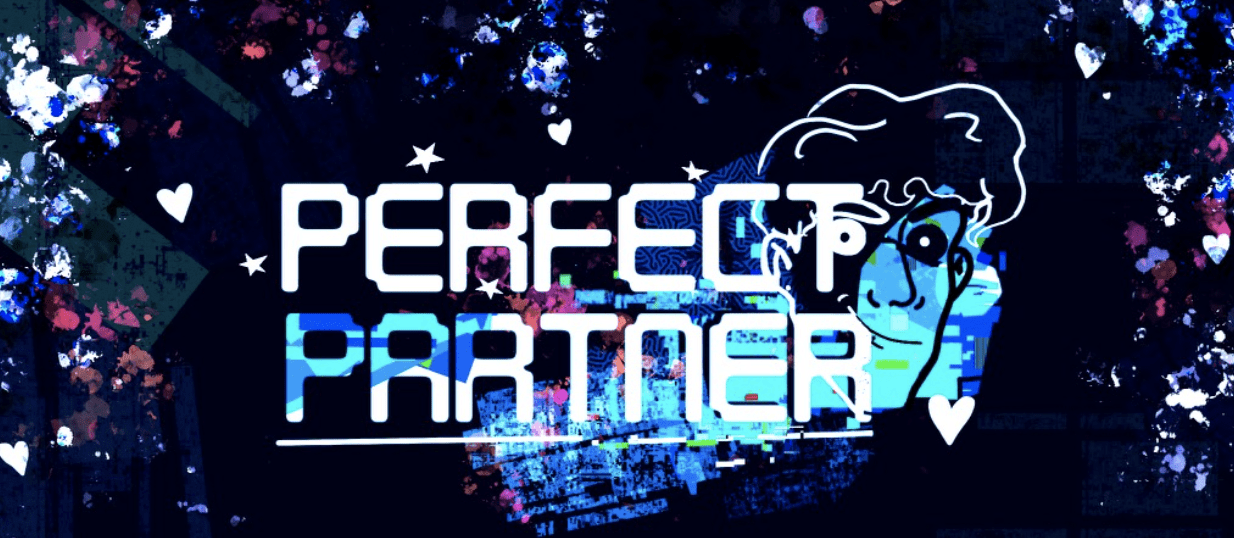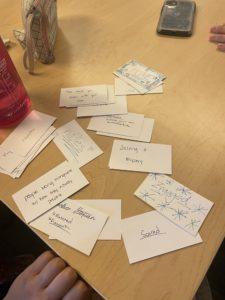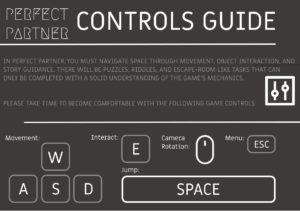Perfect Partner:
Developed by: Katherine Chen, Esteban Wu, Zoe Lynch, Natasha Kacharia, Delali Azamati, Yousif Mohsen


Build the Game: https://drive.google.com/drive/folders/1JDJlGkmrMiDWvYHJY_DqzBUikuRwXC0K?usp=sharing
Table of Contents:
Our Playtesting Experiences (At the end)
Artist Description:
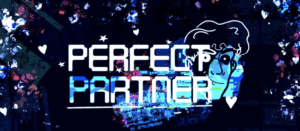
Perfect Partner is an exploratory narrative-based game that sits in the psychological thriller genre. Perfect Partner takes players on the wild ride of experiencing betrayal in a futuristic world after having been cheated on, being fueled with rage to get back at your husband and ordering a “Perfect Partner,” and the eerie realization that getting everything you ever wanted from a partner might be more haunting than it is comforting. Perfect Partner takes everything to the extreme, and really pushes players to question whether sometimes “evil” actions actually are indicative of an evil person, or a broken person. Empathy is an emotion we draw on in Perfect Partner and we carefully crafted text and character interactions in a manner where it is difficult to pinpoint the often radical main character as the villain in the story. Perfect Partner is a psychological thriller that will leave you with more insight into concepts of responsibility, commitment, rage, and desire.
Coming to An Idea:
The beginning:
Initially, we had set out on creating a horror game. Horror was a genre we were all passionate about, and we were able to brainstorm a ton of different possible concepts that spin the horror genre into a new direction. We loved a good horror story, and thus, we were determined to create a scary story, embedded within a game.
Some of our brainstorming concept cards — all leaning towards horror haha
Coming to a concept:
Upon completing our mood boards, we realized that everyone had a completely different interpretation of what horror meant to them. To some of us, horror was rooted in the future, to others of us, horror laid in romance, and some of us just took the mood boards as a chance to talk about our own fears. By looking at all of the different ways we interpreted horror, we began to think about common tropes that tied together all of our ideas. We each took turns describing what we’d like to see in a game, and eventually, we were able to put together everyone’s input to settle upon a horror-romance thriller game. Our game would follow the main protagonist who underwent a romantic betrayal and calls on a futuristic robot to be their new partner in order to cope. This is sweet at first, but slowly turns bitter as our protagonist ends up getting everything they ever wanted, but to the extreme. Using this concept, we drafted up a version of our story broken up into 14 scene sequences that follow our protagonist through her journey to slow insanity as a result of her betrayal and the robotic partner’s manipulation.
Determining the perspective:
Now that we had our story draft, our next couple of meetings revolved around trying to decide what would be the best way to communicate our narrative. Would it be better communicated to players through a 2D or 3D perspective? What would be better for fun gameplay? What would be manageable given our current workload? These were all questions we grappled with during our design process, and we consistently went back and forth with the best approach. We first decided on a 2D direction, and we created assets and materials for a 2D game. However, as we began to try to tell our story and discuss gameplay mechanics, we began to see that a 2D approach proved extremely difficult for solving the exploratory puzzles we felt passionate about, and that a 2D approach limited our ability to play with traditional horror concepts that we all more often associated with a 3D game. Thus, given our experience being stronger with 3D games, our puzzle mechanics, and story-telling strategies, we instead decided to shift to a 3D direction for our game.
Balancing story and puzzles:
Once our medium for story communication was solidified, we began to put together our story. At first, we placed a particular emphasis on the use of puzzles due to our experience with playing narrative games in section. Earlier on in the process, we had played Night in the Woods, a narrative-based game that no one in our group found engaging at all due to the lack of any real gameplay mechanics which reduced the game to being a clicking simulator. Thus, because we found Night in the Woods to be extremely stale due to how it over-emphasized narrative, we wanted to push puzzles in our game in hopes of being a lot more engaging. So, we designed a puzzle for every sequence in our game. We had puzzles to unlock phone passwords, exploratory puzzles where you had to search for materials, and crossword puzzles that had to be solved through various clues littered throughout the game. However, upon play-testing, and discussing within our group, we realized that pushing these puzzles came at the cost of a fragmented narrative. Oftentimes, when we wanted to push a puzzle, it would force the narrative to stop in a sudden place, and gameplay felt scattered. Upon a LOT of deliberation, we felt we were much more passionate about telling a good story than having an escape-room-style game with puzzles littered throughout. Thus, we decided to move forward in a narrative-focused approach to game-making. For our particular slice, we planned out each scene in this document:
Flowtable: https://docs.google.com/document/d/16UG3VSq8N-4N2wCMxXI5LLxXQysYqQI6RGNIAQq6xHI/edit?usp=sharing
Some of our earlier storyboards of particular things we wanted to highlight in the slice are shown below (please use ctrl + to zoom in on the storyboards):
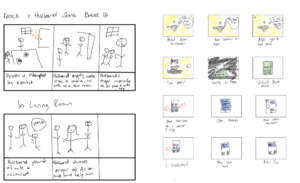
Intentions & Objectives:
We wanted to create a psychological thriller, and thus a lot of our initial objectives focused on getting a really good narrative. Thus, we had to do a LOT of reading and play a ton of games that focused on story, and took particular interest in horror genres and psychological thrillers. Our team members played:
- Half-Life
- Life Is Strange
- Outlast
- The Mimic
- Resident Evil
- Five Nights at Freddy’s
- Left 4 Dead
- Doki Doki Literature Club
- Her Story
- Bioshock
- Night in the Woods
Coming out of these story games, we had both positive and negative experiences regarding text delivery, story cohesion, and mechanic navigation and so for our own game our main objectives were:
- Have a narrative be the primary focus of our game, similarly to the experience we had in playing Doki Doki Literature Club
- Expand our narrative to be digested through an exploratory approach, similar to the experience we had in playing Life Is Strange, and Half-Life
- Communicate our story through gameplay and text, and not overly rely on text communication alone, something that we did not like while playing Night in the Woods.
Overall our game will be:
- Narrative-based
- Exploratory
- Emphasize Discovery Fun
- Embody a psychological thriller
- Make use of activities, puzzles, and most importantly the story itself to progress through gameplay
Target Audience:
- Age: 13+
- Favorite Genre: Horror / Psychological Thriller / Exploration
- Experience Level: Low
- Average Weekly Gameplay Time: 1 hour +
- Platform: PC
- Enjoys narratives and discovery 🙂
Formal Elements Within the Game:
Rules:
Our game rules are limited by what is mechanically feasible for a player to do, though we don’t define any explicit rules, players are implicitly confined to exploring only inside the house (as we’ve locked all mechanics to escape). Furthermore, players are allotted a hint system that they have no limit on usage, and are able to have a choice in whether they want to even explore the story. There isn’t an explicit push to force players to learn about the story of the game, thus, if they so choose, they could just treat the game as entirely exploratory and ignore the narrative altogether, or they can focus entirely on the narrative, or a sweet spot in between, the choices are up to the player!
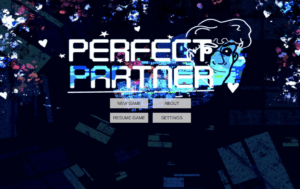
Photo showcasing all of the options allotted to the user prior to gameplay
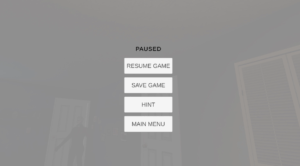
Photo showcasing all of the options a player has available during gameplay
Objectives:
The main objective of our game is to take players on a journey where they live through a woman’s life who has just been cheated on in a futuristic world. The only real goal is to… explore, and live life as though you are that woman. On the designer’s end, we really want players to empathize with the woman in a way where though she may do some bad things, she’s never seen as a true villain due to the story’s ability to communicate a sense of empathy for the woman’s situation. More than anything, we hope the game provides an exploratory narrative that engages a discovery sense of fun!
Outcomes:
After a full playthrough of the game, players will:
- Live through the story of being cheated on in a futuristic world
- Struggle to pinpoint a true villain in the story
- Engage in a series of activities and puzzles to feel more integrated with the story
- Have disconnected from the physical world and entered a futuristic world
Procedures:
- Players enter the main menu of the game upon launch
- Players will be able to adjust their settings, gain a quick premise of the story through the “about section”, enter the game, or exit the game
- Upon entering the game, players will wake up in the middle of the night and read through their husband’s phone
- They will be able to identify that their husband has cheated on them by reading a message on the husband’s phone, before their husband quickly catches them
- The game forwards into the next day, and the player must explore to find out what has happened, further learn about their husband’s cheating, and build a bond with their perfect, robot partner, Rouen instead
- Players will learn about the story as they play through it and eventually realize that things aren’t as they seem, and a perfect partner isn’t so perfect…
Game Mechanics:
The majority of our game mechanics take place through exploratory navigation from a first-person perspective. The game is single-player, and allows players to navigate through a home environment to interact with different objects in order to come together towards a cohesive story. The main controls are locked to movement with “W” to move forward, “A” to move to the left, “D” to move to the right, and “S” to move backward. The mouse is the main method of navigating through the screen, and players are able to press e in order to interact with different objects. Players can scroll through text in interactable objects like the phone, and use the mouse in order to input different things into them. The “Space” key can be used to speed up interactions or skip text altogether. Through all of these mechanics, we allow the player to explore the house they are put in and uncover that their husband cheated on them, order a perfect partner, and live with their perfect, yet no so perfect partner in the game to uncover the story of the game. We integrate first-person perspective to navigate the story and 2D perspective to solve the puzzles.
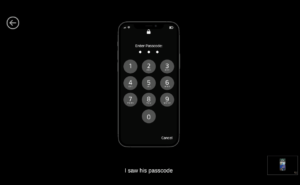
Example of 2D Perspective of solving a puzzle
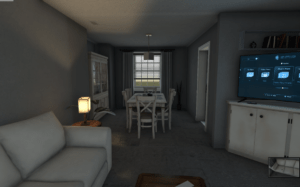
Example of 3D Perspective to navigate the story
With our formal elements having been planned, now came a series of playtests…
Our Playtests:
Playtest 1:
Goal:
- To get a sense of the gameplay mechanics and whether the gameplay felt easy to understand and navigate
- To explore whether anything required further clarification, or if any of the controls were clunky and hard to understand.
Key Insights:
- Gameplay wasn’t smooth, lots of overlooked basic features in UI & Controls
- Interactable objects weren’t obvious to users
- Playtesters enjoyed the narrative components of the game & puzzles were “just right”
Detailed Description:
We learned that our gameplay was not as smooth as we had originally thought. We had overlooked some of the more basic components like screen brightness in our original development. Almost immediately when the playtest started, we had our playtester report that it was hard to see the screen, this led us to note that we had to change the brightness of our game. Furthermore, when it came to controls, we had a combination of click mechanics and key-press mechanics which proved clunky for gameplay. In terms of UI, playtesters reported that the inventory system “felt more like a progress bar” rather than a storage mechanic. Moreover, some of our interactable objects were hard to identify as interactable because they seemed to just “blend in with the background,” and thus it was confusing on what was expected from the player. Lastly, the intention of the game seemed a bit unclear, as, at this point in our development process, we were still torn between going with a digital escape room and a narrative-style game. On a more positive note, our playtesters loved the narrative components, really enjoyed reading through our fake texts, navigating around the house, and felt our puzzle difficulty was “just right” for a narrative-style game.
Goals Addressed:
We got a ton of insight regarding gameplay flow and we were able to deduce gameplay difficulty. Our playtesters at this time felt that the difficulty was just right, so we tried to make little adjustments to things that would alter this so that we don’t move out of the “difficulty sweet-spot.” We did get a lot of insight into clunky mechanics as well, like how to interact with certain objects. Overall, in regards to our goal, the gameplay was easy to navigate, though some mechanics did feel clunky.
Changes Made:
- Changed all clickable objects to “press e to interact”
- Changed descriptions of interactables and fixed bugs like “press NONE to interact”
- Revamped inventory system to become bigger
- Highlighted interactable objects to make it more apparent that they needed to be interacted with
- Focus more on narrative rather than puzzles completely
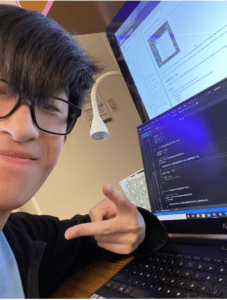
Esteban fixing a HUGE bug in our code haha
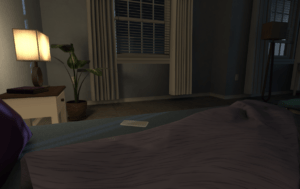
The Before for how it looked to interact with objects
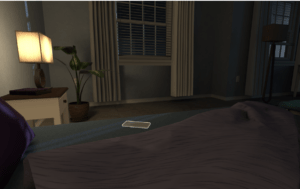
The After for how to interact with objects being highlighted
Future Goals:
- We now are aiming to test gameplay again with the revisions made to interactable objects and UI. Furthermore, we wanted to test whether reducing the number of puzzles in the game made for smoother gameplay through a narrative style.
Playtest 2:
Goal:
- To get a sense of our gameplay experience upon fixing previously dubbed “clunky” elements that made it hard to navigate
- To test whether our game makes sense as a narrative, discovery game after now having a reduced number of puzzles.
Key Insights:
- We found gameplay bugs that made the game objective unplayable (broke the game)
- Exploration needed to be a lot more constrained
- Players new to PC games had a hard time navigating the controls
Detailed Description:
We learned that the gameplay felt much smoother to navigate and a lot of the previous confusing elements were now resolved with our updated changes. However, with those previous confusions gone, the player had more time to really experiment with the game and uncovered a lot of gameplay bugs that made gameplay a bit difficult. For example, we didn’t think to lock any doors in the house, even if the room wasn’t used in order to open up the game for exploration. However, this led to playtesters just leaving the house and venturing outside for the rest of the game, which was problematic as they basically left our game environment, asking, “wait what’s the point of this game,” or “what am I supposed to be doing?” Furthermore, our playtester this time around didn’t play very many PC games and so they were extremely confused regarding navigating the different controls. Lastly, the game felt as though it kind of lost its identity as a narrative-based game according to our playtesters as some of the earlier puzzles did feel fundamental to the story, so we learned that there is some kind of balancing act that comes with implementing puzzles.
Goals Addressed:
We got a lot of insight regarding how gameplay felt and we were able to pinpoint particular critical areas that posed to be problematic for smooth gameplay, like being able to go outside. Moreover, being able to gain the perspective of a non-PC gamer was super helpful in ensuring our onboarding is at a an adequate difficulty level. We were able to see what aspects were easy to pick up from just playing the game, and which aspects needed to be more explicitly explained.
Changes Made:
- We added visual cues for keyboard buttons to click when it’s a player’s first time doing an action
- We added an escape feature that allows you to adjust settings, pause the game and go back to the main menu
- We locked doors that we did not want the player to interact with due to their ability to completely lead the player astray (doors going outside)
- We added back some of the puzzles, and altered them to provide insight to the story upon completion
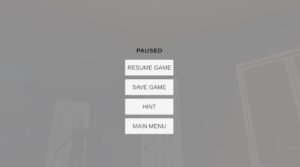
The escape button feature that we added into the game 🙂
Future Goals:
- We want to test whether our game hits the “sweet spot” of puzzles and narrative components blended in to drive an exploratory narrative game
- We want to test whether the gameplay is easy to navigate regardless of player’s background experience
Playtest 3:
Goal:
- Assess the level of difficulty of the game and whether the game feels like an exploratory narrative
- Test whether onboarding does a good job of getting players equipped with the controls and mechanics
- Gain insight on our newly added interactable objects with the interactable T.V screen and images we added 🙂
Key Insights:
- The difficulty of the game felt just right
- Onboarding was smooth to non-pc players
- Interactable objects felt more intuitive to interact with
- Stylistic adjustments to the game needed to be made
Detailed Description:
We learned that the difficulty of the game felt just right again! The game felt engaging in a way that didn’t over-emphasize puzzles, but rather lived through the character which was exactly what we had intended! The onboarding felt just right as well as we were able to get insight from PC gamers and non-PC gamers alike! The visual indicators on what to do were “super helpful” for new players and weren’t distracting for accustomed players. Our newly interactable objects were easy to find and interact with, though we did get some feedback that “things looked a little weird in terms of their sizing, and resolution.” Most of our feedback from this playtest was stylistic, as the overall game mechanics felt pretty fluid!
Goals Addressed:
- We were able to figure out a sweet spot for the level of difficulty (we had multiple playtesters during this playtest and they all shared the same opinions)
- We were able to develop onboarding and determine all of the helpful components necessary in order to smoothly guide players into understanding the controls of the game.
- We were able to get some feedback regarding the intractable items in the game, and make stylistic adjustments to them!
Changes Made:
- Implemented a hint system in the main menu for players to get more information on what their current task is
- Readjusted graphical components like resizing image resolutions, text sizes, and moving buttons around in order to ease accessibility and improve visual quality
- Removed features that allowed some interactables to auto-open
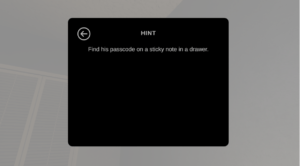
Example of one of the hints given by the hint system!
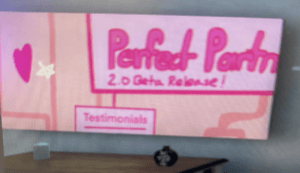
The Before of our graphical interface for interactables, the resolution didn’t fit
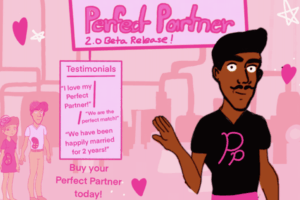
New Display on Interactable which fits the resolution
Future Goals:
- Add in the last few scenes for our game and get some feedback regarding how well those scenes mesh with the rest of the game and whether difficulty or narrative is jeopardized
- Gain feedback regarding the story delivery style and contents as playtesters navigate the game
Playtest 4:
Goal:
- Test the newly added in scenes into the game including the meeting Rouen scene and the dinner scene for fluid gameplay or any points of confusion
- Gain feedback on the narrative delivery style, and what the impressions of the story are so far, whether its theme is coming through and it makes sense in terms of scene ordering
Key Insights:
- Distinct atmosphere was created through the story
- Game felt cohesive to playtesters
- Huge text sections needed to be broken up
- Hint system was a bit hard to find
Detailed Description:
This has been one of our most successful playtests yet! One of our playtesters even said, “There aren’t a lot of negative things I can say about it” and loved playing through the different scenes in our game! In regards to our story, we were informed that the atmosphere feels distinct, and that the filters we’ve put into the game make it stand out as a dark discovery game. The narrative also felt cohesive to playtesters and the game, “pieced together.” Some of the negative feedback we did receive was in terms of text length, however, which allowed us to revamp our delivery of text components and break it up so that it’s not as overwhelming. Furthermore, players LOVED the hint system, though, it was hard to find at the beginning, and thus they recommended we add some indicators to show players how to access hints. The game “felt like a discovery narrative” to the playtesters which was a HUGE plus, and overall, walking out of this playtest, we gained a lot more confidence in our game’s ability to be a fun, exploratory game with a dark twist.
Goals Addressed:
- We were able to receive feedback on our newly implemented scenes and the majority of the feedback was super positive! Slight change to text length would definitely help!
- Our narrative delivery style got a lot of positive and negative critique which was all super helpful! We now know to break up the text in order to prompt more smooth delivery and give the player more visual indicators to helpful navigators in the game like the hint system.
Changes Made:
- We significantly broke up the amount of text that a player has to go through in one interaction, and made it from interactions instead
- We planned out an onboarding system that will help players get introduced to the hint system!

One example of text reduction was to show this to communicate stress, rather than telling the player they are experiencing financial stress
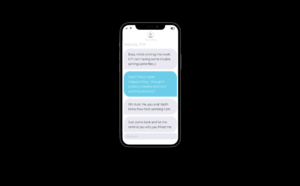
We changed long texts like these to allow a scroll feature to skip interactions if a player chooses to
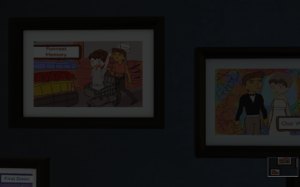
Photographs to show memories rather than reading about these memories to consolidate text
Future Goals:
- We are now seeking to gain insight on our new text delivery system which breaks up the narrative significantly
- We want to gain more insight on other difficult mechanics to learn through a first playthrough in order to optimize our onboarding process.
Playtest 5:
Goal:
- We want to gain insight on the delivery of the narrative after having revised the text delivery
- We want to learn about difficult to navigate mechanics to optimize the onboarding process
- We want to ask playtesters to relay the story back to us so that we can see if there are any points of disconnect in learning the story by playing the game
Key Insights:
- Narrative felt smooth for play-testers & dialouge was better broken up
- Genre of the game was easily recognizable & type of fun
- Hint system is still hard to find intuitively
- Exploration needed to be restricted a tiny bit more to enforce the story
Detailed Description:
We learned that the narrative continued to feel smooth for playtesters, and this time around, the dialouge felt more like a plus to playtesters as they felt like it helped them uncover more parts of the story. Those who didn’t really like reading through the story noted that though they didn’t like that aspect, they recognized it was “part of what a narrative-based game is” like and that for a narrative, exploratory game, the dialouge is doing its job really well! In terms of hard-to-navigate mechanics, the hint system was once again mentioned as being extremely hard to find without being told about it, and we constantly noticed that playtesters would go to completely wrong areas of the house and just get stuck exploring places that weren’t relevant to the story, thus, one of the playtesters mentioned a hint popping out after not finding an object for some time, or more descriptive hints. Lastly, in regards to the story, it was relayed back to us almost perfectly with some feedback being, “I don’t know what’s gonna happen next, but I was enjoying it” and “It was morbid,” which for an exploratory, psychological thriller is exactly what we wanted to hear!
Goals Addressed:
- We were able to get some insightful feedback on our newly broken up text delivery system and learned that it was helpful to navigate the story!
- We got more insight on hard-navigate mechanics and ways to resolve some of those
- We got positive feedback on our story and the messaging seemed to be clear to understand, and engaging
Changes Made:
- We revamped our hint system to be a LOT more descriptive in terms of wording, where eventually you’re kind of just given the answer to what you need so that the story is never blocked from progressing
- We integrated a lot of controls reminders into the game so that mechanics aren’t forgotten by the players
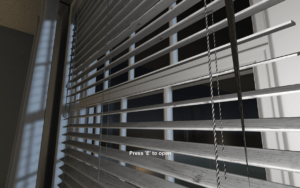
Text to remind players of mechanics in the game as they play
Future Goals:
- Get a new playtester to just go through the entire game and give their raw impressions
Playtest 6:
Goal:
- Since we’ve changed so much at this point, we just wanted to get raw impressions of the game and what type of fun it feels like, whether it is easy to navigate, and feels like a solid gameplay experience from playtesters
Key Insights:
- There didn’t feel like a lot of gameplay integrated into the game, it’s too heavy on narrative
- Hint system faced a significant improvement and was more useful
Detailed Description:
Playtesters absolutely loved the story of the game and felt that it was, “very good.” We did receive critique that “there doesn’t feel to be much active gameplay,” though playtesters did attribute that to it just being a narrative style game which they might not be used to. Since we are doing a slice, we got a lot of insight regarding how opening with this part of the game felt, and to playtesters, they felt it was very solid! Playtesters who were more critical of the narrative genre did suggest possibly adding more activities, not necessarily puzzles, to the game in order to expand the ideal player base and make it feel more like a “game” rather than a story to navigate. Overall, the game felt fluid, the gameplay felt easy to navigate, the hint system was very well-liked, and the type of fun was unanimously dubbed as exploratory and the game felt like a narrative-based game.
Goals Addressed:
- We were able to get a first impression of the game from new playtesters and we got feedback around how the improve the engagement of the game by adding more activities throughout the game!
Changes Made:
- We added more activities into the game through more interactables AND a new CAKE DECORATING activity (which we are super excited about) to develop the story and add more to the fun of the game!
Future Goals:
- We want to get one more first impression of the game from a new playtester and have them test out every single activity we’ve created so far!
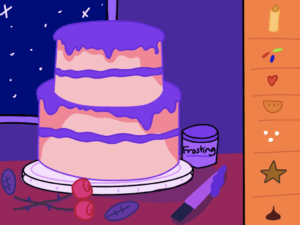
Cake Decorating Activity we integrated into the game!
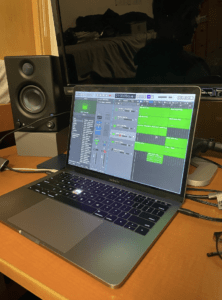
Working on adding audio to our game!!
Final Music for the game: https://drive.google.com/file/d/1tzFNDYY2JAbnQPVdj9CHy-d6sxpPCt3j/view?usp=sharing
Playtest 7:
Goal:
- We want to get one final first impression of the game now that all the feedback has been accounted for and we’ve added more interactive components to the story-based game!
Key Insights:
- The game felt interactive and not distracting from narrative
- Exploration sometimes wasn’t super intuitive
Detailed Description:
Our playtester felt that the game felt just interactive enough for fun gameplay, while also not distracting from the overall narrative. We seem to have hit a really good spot for this slice of our game, and we’re extremely proud of the work we’ve put in. The playtester had extremely positive things to say about the overall product, loved playing the game, and even wanted to play again so that they could get a chance to explore some things they didn’t explore during the first playthrough. The playtester did note that there were some points of gameplay where the “exploration didn’t feel super easy” as they had to “observe some subtle changes” in the map (like they noted the t.v turning on after being off) but said this could be a positive or negative element of exploratory games and it’s up to us to decide whether we want to counteract this. Furthermore, the playtester tended to just immediately explore the game and as a result missed out on some of the mechanics required to proceed, so it might be wiser to restrict the exploratory spaces until some tasks have been finished. We also heard that “it would be nice to include sound,” a goal we’ve been trying to accomplish for a while now haha.
Goals Addressed:
- We were able to get another first impression of the game from a different playtester and receive feedback over a more finalized version of the product! We have some subtle changes to make in regards to players being able to explore, but overall our feedback was positive and gave us a lot of confidence in our product!
Changes Made:
- We locked some of the exploratory space in the house until some tasks were completed (like interacting with the t.v before you’re able to leave the bedroom)
- We started to add an onboarding system that we’ve been planning for a while now through the different playtests into the game to allow for players to quickly learn the mechanics.
- We added a reminder for how to use the main menu to access the hint system to ease access
- We added sound into some parts of our game like the main menu and ambient sound to the night scene!!
Future Goals:
- CELEBRATE OUR PROGRESS!!!
- Complete the write-up and prepare the project for submission!
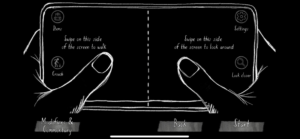
Inspiration for our onboarding – Our onboarding is as you play so it would be so many images to link, but basically reminders come up like this as you play!
Pop-up to tell players about all of the controls in our game 🙂
Video From Playtest:
https://drive.google.com/file/d/1eUzNdgLmFWCCPKsUC-Yz233zEl_DO0jR/view?usp=sharing
Future Directions of the Game:
We have completely finished writing out the entire narrative of the game! We have linked it right here:
In the future, we really want to bring this entire story to life! Having planned out the entire story and all of the interactions, this is our immediate next step. We would love to have the game be tested on a more massive scale upon it being completed, and would love to make our slice a whole. Our game makes use of an engaging story, and implementing this story beyond the slice would evolve our gameplay to provide a much more insightful message, and more engaging gameplay experience. Most immediately though, we would LOVE to feature our soundtrack into the game and actually implement it into gameplay. We got to work on a super cool music track, and had it produced for the game, but we ran out of time when it came to actually embed it into the game, so immediately after submitting, we’re going to add it in haha! Though we were able to add some sound into our game, we would’ve loved to include the soundtrack into gameplay itself so that the game feels much more immersive.
Playtesting Experiences:
Yousif: I playtested Dorm break! This game capitalized on problem-solving and challenge types of fun. There was an element of discovery as we attempted to figure out what was going on in the story and began to put pieces together slowly. The game had a level of difficulty that was just right, with hints scattered throughout in order to ease the gameplay experience. The elements of the puzzle felt cohesive and I never had a moment where I felt like the game theme didn’t match or I was completely stuck. The game didn’t require a lot of background knowledge and gave you all the information required in order to solve the story. It was really fun to group up with 3 other players and attempt to solve a mystery! The game lasted about 20 minutes, and was definitely made for those 13+ who enjoy the mystery and narrative genre as the premise of the game was to put pieces together to unravel a larger story!
Delali: I playtested Escape From Your Mind! This game was about attempting to escape from a really bad substance trip. The game had a lot of different elements that were extremely interactive and fun. My personal favorite was the magnetic maze which we had to get someone to guide us through! It was a discovery kind of fun! The level of difficulty was just right, though at times, I did feel as though there was some background experience required for some puzzles. For example, there was a puzzle where we had to determine which identities belonged to which person, and in this puzzle, the game assumed that we’ve solved puzzles like the “exclude/include” puzzle format before, which was hard to adjust to at first, but once we figured it out felt very smooth! The game lasted about 25 minutes, and seems to favor those 13+ who enjoy puzzle-solving, narrative, and hands-on activities like traditional puzzle components such as mazes, and include/exclude formats for problem-solving.
Zoe: I was a note-taker for the final playtest day! It was really fun to watch everyone’s reaction to playing the game we’ve worked so hard on! The playtesters loved the immersive story-line and said they felt a discovery kind of fun as well as challenge, and were able to problem-solve and navigate the in-game mechanics with ease, regardless of their prior experience with computer games! This was a relief as this was a product of so much effort in order to get to this place! The playtest lasted about 20 minutes, but some playtesters stayed for a lot longer just to explore the game even further, and thus I’d assume an exploration fun was also something our game capitalized on! Players really liked the level of difficulty and said that it allowed them to feel immersed in the story and focus on what’s going on narrative wise rather than challenging puzzles. The puzzles enhanced the gameplay experience by adding more to the story and allowing for fun game-play breaks in between, like decorating a cake!
Katherine: I was a moderator for the final playtest day! Moderating got so much easier with our final product. It was really interesting to see just how much onboarding has made a difference in the player’s ability to navigate the game on their own. We had no real gameplay questions during the playtest, and most of my moderating was getting to watch playtesters enjoy our final product! The hint system, onboarding once a game is launched, and main menu helped create such a smooth gameplay experience for our playtesters. They were able to enjoy discovery and narrative kind of fun with added challenges in between to freshen up gameplay. The playtest was around 20 minutes, with some lingering playtesters who wanted to explore further. We were able to get multiple playtesters and received such good feedback. It was really nice to see our hard-work pay off!
Esteban: I playtested an early iteration of SpaceMail. At this point in time, the team was still working on the final Unity prototype, so I played through a version on Google Slides that actually went surprisingly well. The team spent a lot of time working on the backstory and characters, in order for the player to feel engaged and invested in the story. Care was also taken to design items and letters to be indicative of their underlying affiliations, with built in replayability as players want to find all the possible endings. I recommended some sort of checkpoint system, as dying currently causes the player to restart from the beginning, which may be frustrating if the player is targeting a specific ending. I also recommended reconsidering the use of money and freeing your family, as in the grand scheme of thing it appears that the system is irrelevant to the actual ending a player receives. Another thing that I noticed was that SpaceMail is extremely close to another existing game, Papers, Please. Some would say that it is essentially identical, just re-skinned with a different story and context. I would love to see how SpaceMail intends to differentiate itself and create a new, unique experience.
Natasha: I playtested Ma Nesa! This game was a digital escape room made on Figma. The main elements of fun were exploratory and discovery, but there was also a narrative element. The puzzles were fun after I knew what I was supposed to solve for; however, the puzzles was not super intuitive to me. Thus, the moderator often had to give me an initial hint for me to be able to solve the puzzle and move on to the next level. I also thought the puzzles got repetitive. For instance, the first set of puzzles was an exploratory puzzle in which I walked around the forest trying to find the shape in nature that matched the design. As there were 5 different puzzles with all the puzzles getting harder, I assumed that this was the entire game. My favorite part of the game was defiantly the graphic design and the interactions; they were so beautifully done! I, unfortunately, was not able to finish the game during playtesting, but it was really fun and thoughtfully designed!


